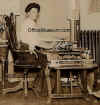Early Office Museum
Vintage Office Photographs
~ 1904-1907 ~
When no date is provided in the Description column below, we
do not know the date of the photograph.
We have placed undated photographs in their likely chronological order.
If the source in the right-hand column is anything other than "Early Office
Museum Archives,"
we do not have the ability to grant permission for use or to provide a high
resolution image..
| Click Image to Enlarge | Description | Source |
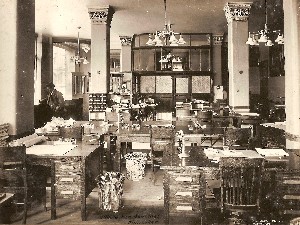 |
General Office, Milwaukee Sentinel, Milwaukee, WI. The photographer is Jos. Brown of Milwaukee. The office contains candlestick telephones and a letter copying press but no other office machinery. The Milwaukee Sentinel was founded in 1839. In 1995 it merged with the Milwaukee Journal to become the Milwaukee Journal Sentinel. A photo of the home library of Frank J. Stern by the same photographer is glued to the other side of the card to which this photo is glued. Frank J Stern was VP of a dry goods company in Milwaukee during the first decade of the 20th century. | Early Office Museum Archives |
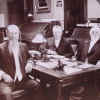 |
President Joseph F. Smith (left), 2nd Counselor Anthon H. Lund (center), and 1st Counselor John R. Winder, Presidency of the Church of Jesus Christ of Latter-day Saints, stereoview, copyright Underwood & Underwood 1904. Aside from the copyright date, the photo must date from 1901-1910. All three men were appointed to these positions in 1901 and held these positions until 1910, when Winder died. The machine in the foreground is an American dating stamp, which was patented in 1871-76 and sold until at least 1913. | Early Office Museum Archives |
 |
Four women in office with document files. | Private Collection |
| Five employees using Multigraph machines, 1905. Gammeter Multigraphs, introduced by the American Multigraph Sales Co. in 1902, were used to produce form letters that looked as though they were individually typed. | Minnesota Historical Society, Neg. No. 7636. | |
 |
Office with three men and a woman, 1905. A telephone mouthpiece is mounted on a long tube that presumably was swung back and forth so that it could be shared by the men who seated on opposite sides of the partners' desk. There is a large document file. The photo was dated by a wall calendar. | Early Office Museum Archives |
| Click on link at right to see photo. Click the "Back" button on your browser to return here. | Office of Pope Manufacturing Co., Hartford, CT, c. 1905. Pope Manufacturing made Columbia bicycles and, around 1890, also made World index typewriters. | Connecticut History Online.Click on bar above photo to enlarge. |
 |
Office with clerks working at slant-top standing desks. | Private collection. |
| "A Negro Magazine Editor's Office in Philadelphia," c. 1904-07. Writing about employment conditions in Northern cities, the author states "A good many Negro printers, pressmen, and the like are now found in Negro offices (over 200 newspapers and magazines are published by Negroes in this country). I know of several girls (all mulattoes) who occupy responsible positions in offices in New York and Chicago." | Ray Stannard Baker, Following the Color Line, 1908, p. 138. In Early Office Museum Archives. | |
   |
Larkin Administration Building, Buffalo, NY. The building's architect was Frank Lloyd Wright. The Larkin Company
was a mail-order house that sold soap and other household products.
The top photograph shows the atrium c. 1906. The bottom photo shows a room beside the atrium c. 1930. The building was demolished in 1950. |
Private collections (top two) and Buffalo & Erie County Historical Society (bottom) |
| Jennie Kelso and her uncle John B. Higbee in his office at the Bryce, Higbee Co., Pittsburgh, PA, January 1906. The company was a glass tableware manufacturer from 1879 to 1907. The company's products are visible on the table in the foreground and on top of the desk in the background. The company's founders included John B. Higbee and Charles K. Bryce. The man seated just left of center, directly facing the camera, is probably John B. Higbee, who died in December 1906 at the age of 64. The company's factory was in Homestead, PA, 7 miles SE of downtown Pittsburgh. A city map or aerial photo on the wall above John Higbee is labeled "Homestead." That map has a crude hand drawing of the factory (bottom center). The 1907 Monongahela river flood destroyed the company's factory and ended the business. | Early Office Museum Archives |
|
 |
Large office, photograph created by the Lawrence Co., Chicago, IL, 1906. Someone has written on the back: "W. D. McAllister, BUKA DEPT." [Rescan and replace] | Early Office Museum Archives |
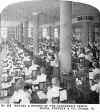 |
"Making a Record of the Customer's Order," No. 23 in a boxed set of 50 stereographs entitled "A Trip Through Sears, Roebuck & Co.," Chicago, Ill., 1906. The set of stereographs is advertised with a 1906 date in the 1908 Sears, Roebuck catalog. Sears, Roebuck employed nearly 2,500 clerical workers in its administration building. The stereograph card reverse states, "During the busy season of the year, six hundred young women are employed in this room, the picture showing only a portion of this great office. The work of transcribing customers' orders to merchandise order tickets is performed on special typewriters, four hundred of these typewriters being in use at the present time." The special typewriters are Elliott-Fisher book typewriters. | Early Office Museum Archives |
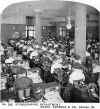 |
"Stenographic Department," No. 26 in a boxed set of 50 stereographs entitled "A Trip Through Sears, Roebuck & Co.," Chicago, Ill., 1906. Reverse states, "In this room between one hundred and fifty and two hundred young women are engaged in transcribing letters dictated by correspondents throughout the institution. This dictation is received by two methods. By one method the typist goes directly to the correspondent and takes his dictation in shorthand. By the other method the correspondents dictate their letters to a graphophone. The cylinders are then sent by messenger to the graphophone division of the Stenographic Department, where each operator has a graphophone and typewriter." Typists are using Oliver typewriters. | Early Office Museum Archives |
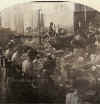 |
"Section of Mail Opening," from a stereoview series showing various operations of The T. Eaton Co. Ltd, Winnipeg, Manitoba, Canada. Eaton's, which was founded in Toronto in 1869 and went bankrupt in 1999, was Canada's largest retail department store chain. The company introduced a mail order catalog service in 1884. In 1905, it opened a store, and catalog fulfillment business aimed at Western Canada, in Winnipeg. "This picture shows a small section of our mail opening staff, of which there are about 45, including cashiers. Here all our mail is received. The mail order letters are opened by a machine which is capable of opening letters ten times as fast as could be done by the old fashioned hand method. The letters are then given to the mail openers who carefully read them, check the amount of money received, and make out a cash tally showing the amount enclosed. In addition a record card is made out, showing customer's name, post office, station, province, amount of money remitted, and order number. Thousands of letters are handled daily." See also the following photograph. | Early Office Museum Archives |
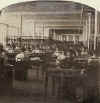 |
"Section of Copying," The T. Eaton Co. Ltd, Winnipeg, Manitoba, Canada. See the discussion of the preceding photo for background on Eaton's. "...[F]rom 100 to 175 young women are here employed. When the mail openers have opened the letters, and the cashiers have taken off the money, the young lady receiving your letter carefully reads it and makes abstracts on the order sheets for goods from each department. Every hour these orders are sent to the proper departments and your original letter along with our shipping record is sent to the transfer or assembling section. [The goods] are sent here and connected with the original order, which, when complete, is sent to the packers." | Early Office Museum Archives |
 |
"Recording Department," The T. Eaton Co. Ltd., Toronto, Ontario, Canada. The T. Eaton Co. had mail order offices and warehouses in both Toronto and Winnipeg in the early 1900s. See the two photographs immediately above. | Early Office Museum Archives |
 |
"Our Office," C. W. Stuart & Co., Newark, NY. C. W. Stuart began selling fruit trees, berry bushes, and roses direct to customers in 1852. C. W. Stuart & Co. became a very large direct sales company. During the 20th century its sales force sold an increasingly wide range of products. The company was in business at least as late as 1972.
The back of this early 20th century stereoview card states: "Our business has been growing very rapidly and we now own and occupy three floors of the entire building. The picture shows only a small portion of the upper floor. [The picture shows eight booths.] Each of the booths contains a stenographer busily engaged in writing letters to our salesmen and customers. The letters are all dictated by the correspondents and managers of the different departments. In the foreground, near the railing, may be seen one of these correspondents dictating letters to one of the stenographers. Everything has to be done on a perfect system and must move like clock-work in order to get the mail properly read and answered the same day it arrives. The stenographers are under the immediate supervision of the department managers, who in turn make...reports each day to the President and General Manager. This picture gives but a faint idea as to the number of clerks employed on this floor, but it gives a fair idea as to how the room is arranged for their convenience. On the next floor below we have the book-keeper's department, in which are engaged from 6 to 8 expert accountants who are kept busy crediting in the orders as they come from our large force of salesmen, and properly entering these orders on the books of the Company. Here are located the large fire proof vault and safes, built especially for storing the orders with perfect safety as their loss by fire would make an almost irreparable loss. On this floor we have also our letter folding machine. This machine will fold from 20,000 to 30,000 letters per day. We have a very large force of clerks employed on this floor addressing the tags to be used in shipping the stock to our customers. On the different floors of the building are located the private offices of the officers of the Company." |
Early Office Museum Archives |
 |
Workers using Edison Business Phonographs in Mr. Broyles's office, 1906. | Edison National Historic Site 29320054 |
 |
Office interior with a desk from the 1870s, 1906. The office has two 1906 wall calendars. One is an advertisement for the National Life Insurance Company, which was established in Montpelier, VT, in 1848; the company is still headquartered there. | Early Office Museum Archives |
| Four men in office with two typewriters and candlestick phone. The typewriter on the right is a Remington upstrike. On the wall is an advertisement for The Lake Shore Route, which was the Lake Shore and Michigan Southern Railway Co. This railway was formed in 1869 by the consolidation of existing railways and was controlled by Cornelius Vanderbilt and then William Vanderbilt. This railway was consolidated with the New York Central in 1914. | Available from Ronald Beck www.centuryimages.com |
|
| Office in tire store. No date. Typewriter, candlestick telephone, Star pen rack, pennant advertising Stronghold Tires. | Available from Ronald Beck www.centuryimages.com |
|
   |
These pictures show the interiors of three offices in North
Dakota.
The top photograph in the column to the left shows Ellen Livingstone using a book
typewriter in an office in 1906, with her boss in front of her. This
photo is dated by the wall calendar. Immediately below in the present column is an
enlargement of Ms. Livingstone and the book typewriter from the top
photograph in the column to the left. |
Early Office Museum Archives |
  |
Two large offices at the same company. These office may be at an architectural, construction, or engineering firm, because a third photograph (not shown here) of another office at the same company shows 15 men working on large sheets of paper at tilt-top desks of the types used by architects. The top photo here includes a calendar advertising engines and boilers made by the Wm. Powell Co. A company with that name, located in Cincinnati, OH, has manufactured valves since 1846. The bottom photo includes a calendar advertising Massachusetts Mutual. Massachusetts Mutual Life Insurance Co. was founded in Massachusetts in 1851; in 1868 it opened its first West Coast office, and it was a national firm when this photo was taken. The women's clothing and hair styles, and the presence of vertical file cabinets, are consistent with a date in the very early 1900s. | Early Office Museum Archives |
| James M. Brickhouse, Little Rock, AR. Brickhouse was a politician. Photo shows a Smith Premier typewriter. | Private collection | |
| "Private Office of Advertising Manager." At the right, under a metal hood, is a Card Index Addressograph of a type that we have seen in 1907-10 advertisements. A wall calendar advertises the American Bonding Co. of Baltimore. Until 1901, the latter company was named the American Bonding & Trust Co. of Baltimore. Around 1902, the name was changed to American Bonding Co. of Baltimore. | Early Office Museum Archives |
|
| Office of the Northwestern Farmer, a periodical publication, probably Menominee, MI. Publication years for the Northwestern Farmer included 1907-08. Menominee is on the Michigan-Wisconsin border. A Wisconsin Telephone Company directory and upstrike typewriters are visible in the photograph. | Early Office Museum Archives |
|
| Employee at desk in railroad terminal, King Street Station, Seattle, WA, by photographer James P. Lee, 1907. King Street Station was built during 1904-06. Dated by wall calendar. Photograph shows an upstrike typewriter and two candlestick telephones. | Manuscripts, Special Collections, University Archives Div., University of Washington Libraries, James P. Lee Collection, No. 294 | |
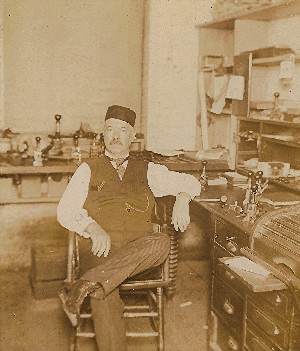 |
John J Chattarray at desk with many date stamps. | Early Office Museum Archives |
 |
Actuarial Division, Metropolitan Life Insurance Co., New York, NY, postmarked 1907. | Early
Office Museum Archives |
 |
Filing Section, Metropolitan Life Insurance Co., New York, NY, postmarked 1907. | Early Office Museum Archives |
 |
Card Cabinets Containing Records of the Ordinary Insurance Department, Metropolitan Life Insurance Co., New York, NY. | Early Office Museum Archives |
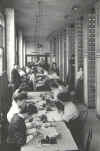 |
Filing Section, Metropolitan Life Insurance Co., New York, NY. | Museum of the City of New York, Byron Collection (93.1.1.6910) |
 |
Office with 15 women and 2 men. Photograph by Maple Studio, Marblehead, MA. | Early Office Museum Archives |
 |
Man at roll-top desk in office with safe and letter filing cabinet. A calendar advertises the National Carbon Company, which existed from 1886 to 1917. The content of the photo suggests a date during the early 1900s. Because a calendar shows that March began on Tuesday, the photo must date from 1904 or 1910. | Early Office Museum Archives |
 |
Office, Germany. |
Early Office Museum Archives |
 |
Office with accounting machines, B-logo Business Systems Dept., 1907. Photo shows a Burroughs adding machine and a dictating machine. | Charles
Babbage Institute, Univ. of Minnesota, Minneapolis, Burroughs Corp. Collection, cb000184. |
 |
"The Accounting Department, E. & J. Burke, Ltd., Times Building, Times Square, New York," NY, postmarked 1907. E. & J. Burke was an Irish brewery and a New York distributor of alcoholic beverages. All employees in the photo are men. See the photo immediately below for the company's Correspondence Department, where all the employees are women. | Early Office Museum Archives |
| "The Correspondence Department, E. & J. Burke, Ltd., Times Building, Times Square, New York," NY. See discussion of preceding photograph. | Early Office Museum Archives |
|
 |
Hospital office with Miss Brady at the telephone switchboard and Superintendent Taul at his desk. Behind Mr. Taul is a sectional filing cabinet and an upstrike typewriter. There are two candlestick telephones. | Early Office Museum Archives |
 |
Office with Brunsviga pinwheel calculating machine and Remington No. 7 upstrike typewriter. No location or date. Probably taken in continental Europe. Brunsviga pinwheel calculators were introduced in 1892 and sold for decades. The Remington No. 7 was introduced c. 1897. | Early Office Museum Archives |
 |
Office with five Addressograph addressing machines and a Multigraph for printing form letters, probably New York, NY. Eight female workers are operating the machines and a man is standing in the background. | Early Office Museum Archives |
 |
 Office, France, c. 1907. One man is using an Oliver or Courier typewriter. This photo was part of a set of French photos of a group of cyclists; see image to right for another photo in this set. A poster says "Cycles & Chaines" (which translates to "Cycles & Chains," which is a term used in various sciences). The spine of a book has the word "Paris" and the year "1907." A hat has the words "Echo Sport" (which are the same in French and English). |
Early Office Museum Archives |
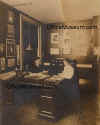 |

Executive and stenographer or assistant at The Red Book magazine, Chicago, IL, 1904-1907. The frame on the desk contains a cover image from the magazine, and the wall to the left has several more covers with images of women. According to Wikipedia, "The magazine was first published in May 1903 as The Red Book Illustrated..... The name was changed to The Red Book Magazine shortly thereafter. Its first editor, from 1903 to 1906, was Trumbull White.... In its early years, the magazine published short fiction by well-known authors, including many women writers, along with photographs of popular actresses and other women of note. ... When White left..., he was replaced by Karl Edwin Harriman, who edited The Red Book Magazine...until 1912." The man in the photo may be either White or Harriman. The address side of this unused undivided back postcard states: "Post Card. This side for the address only." That format and wording date the postcard to 1901-1907. July 1913 cover of The Red Book Magazine |
Early Office Museum Archives |
Photographs are copyrighted. All rights are
reserved by the copyright holder, the owner of the photograph, and the Early
Office Museum.
We are interested in purchasing interesting vintage photographs of office
interiors of the types displayed above.
